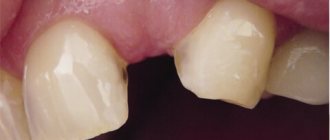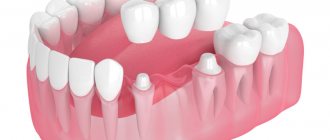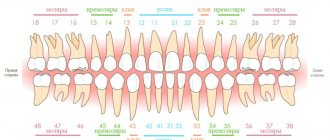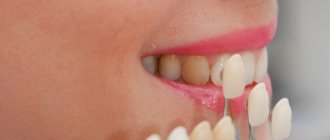In recent decades, therapeutic dentistry has received a significant impetus for development. This is due to the emergence of new materials and working methods, with the help of which it became possible perform restoration of the crown part of the tooth even in the presence of significant defects.
At the same time, it is possible to repeat the smallest individual features of the patient’s dental apparatus. It is thanks to the precise recreation of the anatomical shape of the damaged tooth that structures made of composite materials are harmoniously combined with the environment in the oral cavity.
Restoration of the tooth crown
Indications for restoration
There are quite a few situations that will require you to resort to a restoration procedure. The main reasons include:
- Congenital anomalies of dental development, too wide interdental spaces.
- Minor injuries to hard dental tissues.
- Destruction of enamel as a result of the carious process and other reasons.
Various circumstances can lead to the formation of defects in the hard tissues of the tooth, for example, poor-quality water, lack of vitamins and minerals in food, even improper brushing techniques.
Small defects may not be detected by the person for a long time, which leads to the gradual destruction of increasingly large volumes of enamel and dentin. Therefore, it is necessary to regularly (at least 2 times a year) be examined by a dentist. This will allow restoration of the crown part of the tooth in the early stages and prevent further aggravation of the situation.
Restoration of chewing teeth –
In videos 3 and 4 you can see how the restoration of chewing teeth is carried out with composite filling material. In video 3, the restoration can hardly be called “artistic”, because... The chewing surface of the tooth with all its fissures was restored only “satisfactorily”. However, this video does a good job of showing the restoration of the side walls of the tooth and the contact points between the teeth. Video 4 shows the final stage of a truly artistic restoration.
Basic restoration techniques
In modern dentistry, many methods are used to eliminate hard tissue defects. This allows you to apply an individual approach to each patient and choose the most effective ones depending on the condition of the tooth. The most common methods include:
- Filling. The filling materials currently used make it possible to reliably eliminate even large defects and restore not only the chewing function of the tooth, but also the aesthetic appearance of the entire dentition.
- Veneers. These are thin ceramic onlays; they are widely used to correct defects and compensate for wide interdental spaces.
- Crowns. An old but reliable method of restoring teeth. Thanks to the use of new technologies, even very large imperfections (loss of 70% of tissue) can be eliminated with the help of crowns.
- Fiberglass reinforcement. Used to compensate for the loss of one tooth. Its artificial counterpart is built onto a base made of fiberglass threads, which are attached to adjacent teeth. There is no need to sharpen them.
Restoration of the tooth crown
The technology of stump overlays is also widely used. It consists of inserting a pin into the surviving root. A crown is then installed on it or a composite material is applied layer by layer. The method allows you to restore even a completely lost coronal part, if you managed to save the root.
Tabs
If the coronal part is preserved, but there is a risk of further destruction, inlays can be installed. They are:
- restorative - if only the crown is damaged,
- stump - if you need to restore not only the crown, but also the root.
Manufacturing includes the following steps:
- removal of necrotic tissue and formation of a cavity,
- taking an impression,
- making a plaster model,
- computer modelling,
- heat treatment,
- installing an inlay into the tooth cavity.
Crown extension algorithm
In the process of building a crown using composite materials, it is especially important to accurately replicate the natural anatomical shape of the tooth surface. The chewing surface of molars is particularly complex. It is diamond-shaped and includes four tubercles:
- Paracone.
- Metacone.
- Protoconus.
- Hypocone.
Additional tubercles may also be present, for example, the Karabel tubercle. Between the tubercles there are grooves separating them from each other. The dentist must reproduce all these structures as accurately as possible, using composite materials and special instruments. Due to this, the chewing load will be evenly distributed, which will prevent further tooth decay.
To simplify orientation, a special coordinate system is used, which divides the tooth into four sections:
- Medial.
- Vestibular.
- Distal.
- Palatine.
This division makes it possible to more accurately calculate the pattern of tubercles and grooves on the functional surface of the crown, which significantly facilitates the formation of a new surface.
The restoration algorithm looks like this:
- Cleansing teeth from plaque and other contaminants. Then a material of a suitable color is selected and a local anesthetic is administered. In essence, this is a preparatory stage at which everything necessary for further actions is prepared.
- Tooth preparation. It involves the removal of parts of the crown that are injured or affected by caries. It is performed within the boundaries of healthy tissues that have retained their natural characteristics.
- Application of materials. To imitate dentin and enamel, the same composition is used, differing in color. A darker shade is selected for dentin, and a lighter shade for enamel, corresponding to the color scheme of the remaining teeth.
- Formation of a new chewing surface. It involves the artificial recreation of anatomical structures such as tubercles and grooves. This is a difficult stage, since the quality of the specialist’s entire work largely depends on it. To perform it, you will need to use several types of bur (ovoid, needle-shaped, No. 3, No. 4).
Different burs are needed to repeat the shape of the microrelief of the chewing surface, which will fully correspond to the structure of the lost area. After the process is completed, the crown is polished. To do this, use polishing heads made of silicone or circular brushes with polishing paste.
Restoration of the tooth crown
Polishing significantly improves the smoothness of the crown surface. In addition to additional comfort for the patient, polishing serves as a preventive measure for the development of caries and plaque deposits. It will be much more difficult for food debris and bacteria to attach to a smooth surface.
Crown restoration methods
One or two crowns can be restored using one of the restoration methods. This is only possible if the defect is minor and superficial. To eliminate large-scale damage, doctors recommend completely replacing the prosthesis. Next, let's look at the methods used for recovery:
- polishing;
- composite reconstruction;
- replacement of prosthesis.
Polishing is carried out to level the surface of the prosthesis, remove microcracks and chips. After manipulation, the surface becomes smooth and resistance to external factors increases.
Composite reconstruction involves drying the damaged area followed by treatment with boron to roughen it. Then the work area is rinsed with a special composition, and the problem area is covered with composites. After applying each layer, the doctor performs light polymerization.
Features of composite materials used for restoration
There are many different composites that are suitable for restoring the crown of a tooth. These materials are characterized by high strength, durability, are easy to use, and have a moderate cost. This combination of characteristics has made them very popular among both dentists and patients.
The basis of the composite is an organic or modified matrix in which the filler and other components that make up the material are evenly distributed. Inorganic microparticles of different sizes (from 0.01 to 100 μm) are usually used as fillers. Most often these are compounds of barium, aluminum, and silicon dioxide.
In addition to the filler, dyes, stabilizers and other functional additives are added to the composite composition. There are several main types of composite materials:
- Microfilled. Contains many particles of the minimum available size. They have high aesthetic qualities and excellent wear resistance. They are used to work on front teeth and install veneers.
- Macro-filled. They are distinguished by increased strength, but low aesthetics. Large particles create a matte effect and rough texture. Suitable for working with lateral teeth.
- Mixed. Universal compositions that combine the positive qualities of the above varieties of composites. The main disadvantage is that they cannot be used to eliminate cavities.
There are many other types of composite materials, but they are used less frequently, mainly for solving highly specialized problems, for example, keromers, ormokers.
One of the promising modern developments is nanocomposites, which consist of extremely small particles. They have the best performance in all areas. The only drawback of nanocomposites is the high cost associated with the complex and expensive production process, so they cannot be found in all cities; even in Moscow, not all clinics offer such materials to choose from. But over time they will become much more accessible, since this is a new technology that has only recently begun to spread.
Types of dental crowns
Dental restoration: reviews
Very often, patients are dissatisfied with the way the restoration of the front tooth was performed (in terms of its shape, color and transparency).
Those. First of all, complaints are made specifically about insufficient aesthetics, and often the restored tooth simply looks like a real plastic crown, i.e. artificial and unnatural, standing out against the background of natural dental tissues. Examples of unsuccessful dental restorations: photos
Restoring aesthetics during restoration has 3 key points:
- Tooth shape - in fact, the work of restoring the anatomical shape of a tooth is very similar to the work of a sculptor who sculpts his model, but not from clay, but from filling material. Try to mold a tooth from simple plasticine with all its surfaces, cusps and fissures. I think that you will immediately understand that this requires a certain talent and artistic flair.
- Tooth color – it is necessary to achieve full matching of the shade of the restored tooth with the shades of neighboring teeth.
Filling materials have numerous shades (colors). For example, one factory package of Filtek filling material may contain 20 syringes of the material, each of which will have its own shade. The possibility of layer-by-layer application of a material with one shade onto a material with another shade (i.e., their combination) allows you to ultimately obtain all kinds of color combinations. Unfortunately, most dentists simply do not know how to use all the possibilities of modern filling materials and “play” with colors. The problem is further aggravated by the fact that the color of the tooth in the direction from the cutting edge to the neck of the tooth is always different, it changes, and this also needs to be taken into account. Otherwise, the restored tooth will be completely different from the patient’s neighboring “native” teeth. - Transparency of the tooth - in addition to the fact that the tooth changes its color in the direction from the cutting edge to the neck of the tooth, the transparency of the tooth also changes in exactly the same direction. Therefore, when restoring the cutting edge and cusps, those filling materials are used that, after exposure and curing, will have higher transparency.
Types of artificial crowns
Restoration of the coronal part of a tooth is often performed by installing an artificial crown. This technique is used when the destruction process has affected more than half of the tissues. The most commonly used types of crowns are:
- All metal. They can be stamped or cast; their surface is often coated with decorative plating, for example, gold. Although this method of producing crowns has become significantly outdated, it is still popular. This is due to the affordable price and fairly long service life of such structures.
- Metal-ceramic. They are also made from metal, but the top layer is formed from ceramic materials. This significantly improves the properties of such crowns and increases their aesthetic qualities.
There are also completely ceramic crowns. They are made from porcelain or zirconium ceramics.
Installing a crown on a tooth
A dental crown is installed on one tooth in several stages.
- Diagnostics.
To find out whether it is possible to put a crown on a tooth, the doctor examines the oral cavity visually and necessarily sends it for an x-ray.
- Treatment.
Then the necessary treatment is carried out. Most likely, you will have to remove the nerve under the crown and fill the canals.
- Grinding of teeth for crowns.
If the dental tissue is slightly damaged, then the remaining walls are ground down. In the case where the “top” of the tooth is completely missing, a dental inlay is additionally installed under the crown, which will ensure its reliable fixation. Previously, instead of an inlay, a pin was installed; today, a dental crown on a pin is considered an outdated technique, which has a number of complications leading to tooth loss.
- Making dental crowns.
After all the preparatory procedures have been completed, impressions are taken from the patient and sent to a dental laboratory.
- Installation of dental crowns.
This is followed by fitting of the finished product in the oral cavity and installation. Many people are concerned with the question “What are dental crowns glued to?” Orthopedic structures are placed on special cement, which allows the prosthesis to stay in place for a long time and reliably.
All manipulations are carried out over several visits. Making dental crowns is possible in a few hours, provided the necessary equipment is available in dentistry.
Crown on a living tooth without pulp removal
If we are talking about grinding healthy teeth to fix a dental bridge, then an important question arises about the need to depulp the tooth. Everything here is very individual. But, as a rule, doctors prefer not to take risks and in most cases remove the nerve.
Color of dental crowns
Modern technologies make it possible to produce orthopedic structures indistinguishable from natural teeth. Naturally, we are talking about ceramic, metal-ceramic and plastic crowns, and not metal ones. Ceramics used in modern dentistry are able to completely imitate the color and transparency of the enamel of the teeth adjacent to the prosthetic. The same applies to the plastic used to make temporary crowns. But if we are talking about metal-ceramics, then crowns with a zirconium frame can “get into color,” and in the case of other metals, the frame can be visible through artificial enamel. In modern dental laboratories, the color and shade of enamel for crowns is selected according to the Vita scale, which represents the majority of natural tooth shades.
How are dental crowns removed?
There are 3 main ways.
- Kopp apparatus.
Using a special drill, the doctor breaks the cement at the base of the prosthesis, then removes the structure with forceps. - Sawing
. The structure is cut in the center and removed. - Coronaflex.
The crown is removed carefully and without damage using compressed air. The method is expensive, but after the procedure it is possible to re-install an artificial tooth.
Dental crowns are removed if the following problems occur:
Toothache under a crown
Modern materials make it possible to make dental crowns that fit as closely as possible to the tissues of the prepared tooth, however, sadly, the patient sometimes has the feeling that his dental crown hurts. Of course, it’s not the crown that hurts, but the tooth underneath it. Toothache under a crown can mean several different problems, but the most common is the formation of secondary caries in the area where the crown adheres to the tooth tissue. If this happens, be prepared to remove dental crowns, re-prepare the teeth and install new orthopedic structures. If this is not done, the tooth under the crown may completely collapse, leading to its loss.
Caries under the crown
Sometimes this is due to an error by a doctor or dental technician, when the procedures for making or installing a crown were violated: if it does not fit tightly to the tooth, if saliva got under it during installation, if caries was not completely treated, the formation of secondary caries under the crown is more than likely .
Unpleasant odor from under the crown
The smell from under the dental crown occurs when food debris or saliva gets under the denture. Bacteria multiply faster in this environment, causing an unpleasant odor. Inflammatory processes in the dental tissues under the denture also lead to an unpleasant odor.
Important!
Removing dental crowns and installing new ones must be done approximately every 10 years, otherwise you risk becoming one of those users who frantically write in the search bar in their browser: “I swallowed a dental crown, what should I do?!” By the way, modern materials for making crowns are absolutely non-toxic; sharp edges and chips pose a danger if swallowed. Therefore, if it was not a small piece of a fallen-off crown that was swallowed, but the entire structure or a substantial part of it, you should consult a doctor - a surgeon, a gastroenterologist, or the nearest emergency room.
If it hurts under the dental crown
Installing a dental crown is a complex operation. Therefore, after it, pain may be observed for 2-3 days. This is a normal reaction of the body to intervention. Therefore, doctors recommend taking painkillers during this period.
If your tooth hurts for a week or more, you should consult a doctor for a second examination. It is possible that a pocket has formed between the gum and the crown where food has entered. This can cause inflammation. In this case, you need to start treatment as early as possible so as not to lose the tooth.
Pros and cons of crowns
It is impossible to call the installation of crowns a uniquely positive procedure. It has a number of contraindications and disadvantages. But there are much more advantages from it, so it has not lost its relevance for decades.
Advantages
There are significantly more positive aspects of crown prosthetics than negative ones. The advantages of the procedure include:
- maintaining the health of the tooth when it is partially destroyed;
- restoration of chewing function of the jaws;
- protection against tooth decay with removed pulp;
- restoration of intelligible and clear speech;
- possibility of crown replacement;
- restoration of the aesthetic appearance of the smile.
A large number of advantages outweigh some of the disadvantages of the procedure. But they are still worth considering before deciding to install.
Flaws
Like any medical procedure, crown placement is not without its drawbacks. Its disadvantages:
- significant grinding of healthy tooth tissue;
- the procedure is not performed if the root is damaged;
- limited crown service life;
- the need for regular monitoring by a doctor.
Despite the number of shortcomings, dental crowns remain popular and in demand. This is an effective way to restore the integrity of your smile and jaw function without significant financial investment.
Methods for restoring the coronal part of a tooth: indications and contraindications for their use
The crown is the anatomical part of the tooth structure that protrudes above the gum. It is covered with enamel, which is a hard tissue located on top of dentin and makes up up to 25% of the total tooth tissue. The choice of method for its restoration depends on the degree of destruction:
- If it is moderate (up to 50%), a filling made of composite materials is sufficient;
- If it is more serious (50‑60%), a pin is used;
- If it exceeds 60%, a stump tab will be required.
| Recovery method | Indications: | Contraindications: |
| Pin in-channel design |
|
|
| Stump tab |
|
|
| Filling made of composite material |
|
|








